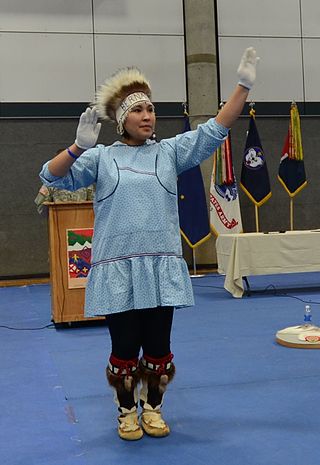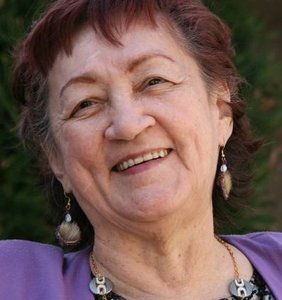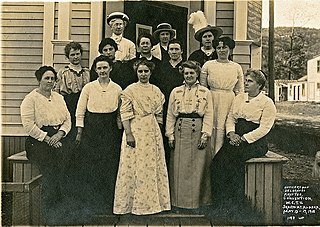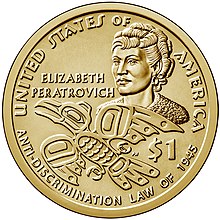
Klawock is a city in Prince of Wales–Hyder Census Area, in the U.S. state of Alaska, on the west coast of Prince of Wales Island, on Klawock Inlet, across from Klawock Island. The population was 755 at the 2010 census, down from 854 in 2000. It is located 90 kilometres (56 mi) from Ketchikan, 11 kilometres (6.8 mi) from Craig, and 39 kilometres (24 mi) from Hollis.

The Civil Rights Act of 1964 is a landmark civil rights and labor law in the United States that outlaws discrimination based on race, color, religion, sex, and national origin. It prohibits unequal application of voter registration requirements, racial segregation in schools and public accommodations, and employment discrimination. The act "remains one of the most significant legislative achievements in American history".

Alaska Natives are the Indigenous peoples of Alaska and include Iñupiat, Yupik, Aleut, Eyak, Tlingit, Haida, Tsimshian, and a number of Northern Athabaskan cultures. They are often defined by their language groups. Many Alaska Natives are enrolled in federally recognized Alaska Native tribal entities, who in turn belong to 13 Alaska Native Regional Corporations, who administer land and financial claims.

The history of Alaska dates back to the Upper Paleolithic period, when foraging groups crossed the Bering land bridge into what is now western Alaska. At the time of European contact by the Russian explorers, the area was populated by Alaska Native groups. The name "Alaska" derives from the Aleut word Alaxsxaq, meaning "mainland".

The Alaska Statehood Act was introduced by Delegate E.L. Bob Bartlett and signed by President Dwight D. Eisenhower on July 7, 1958. As a result, Alaska became the 49th U.S. state on January 3, 1959. The law was the culmination of a multi-decade effort by many prominent Alaskans, including Bartlett, Ernest Gruening, Bill Egan, Bob Atwood, and Ted Stevens.

Facilities and services such as housing, healthcare, education, employment, and transportation have been systematically separated in the United States on racial categorizations. Segregation was the legally or socially enforced separation of African Americans from whites, as well as the separation of other ethnic minorities from majority and mainstream communities. While mainly referring to the physical separation and provision of separate facilities, it can also refer to other manifestations such as prohibitions against interracial marriage, and the separation of roles within an institution. The U.S. Armed Forces were formally segregated until 1948, as black units were typically separated from white units but were still led by white officers.

William Lewis Paul was an American attorney, legislator, and political activist from the Tlingit Nation in Southeast Alaska. He was known as a leader in the Alaska Native Brotherhood, and became the first Native attorney and first Native legislator in Alaskan history.

Elizabeth Peratrovich was an American civil rights activist, Grand President of the Alaska Native Sisterhood, and member of the Tlingit nation who worked for equality on behalf of Alaska Natives. In the 1940s, her advocacy was credited as being instrumental in the passing of Alaska's Anti-Discrimination Act of 1945, the first state or territorial anti-discrimination law enacted in the United States.

The Alaska Territorial Guard (ATG), more commonly known as the Eskimo Scouts, was a military reserve force component of the US Army, organized in 1942 in response to attacks on United States soil in Hawaii and occupation of parts of Alaska by Japan during World War II. The ATG operated until 1947. 6,368 volunteers who served without pay were enrolled from 107 communities throughout Alaska in addition to a paid staff of 21, according to an official roster. The ATG brought together for the first time into a joint effort members of these ethnic groups: Aleut, Athabaskan, White, Inupiaq, Haida, Tlingit, Tsimshian, Yupik, and most likely others. In later years, all members of some native units scored expert sharpshooter rankings. Among the 27 or more women members were at least one whose riflery skills exceeded the men. The ages of members at enrollment ranged from 80 years old to as young as twelve (both extremes occurring mostly in sparsely populated areas). As volunteers, the Alaska Territorial Guard members were those who were too young or too old to be eligible for conscription during the World War II.

The Alaska Native Brotherhood (ANB) and its counterpart, the Alaska Native Sisterhood (ANS), are two nonprofit organizations founded to address racism against Alaska Native peoples in Alaska. ANB was formed in 1912 and ANS founded three years later. For the first half of the 20th century, they were the only organizations working for the civil rights of Alaska Natives in the territory and state.

The Brotherhood Bridge is a road bridge in Juneau, Alaska. The bridge carries the Glacier Highway over the Mendenhall River, acting as a demarcation point of sorts between the urban and rural portions of mainland Juneau. The bridge was named in honor of the Alaska Native Brotherhood (ANB). It was designed by civil engineer Roy Peratrovich, Jr., the son of Roy and Elizabeth Peratrovich, who were leaders in the ANB and counterpart Alaska Native Sisterhood. Bronze plaques on the bridge refer to the Raven and Eagle clans of the Tlingit people. Previous bridges across the Mendenhall River, at or near the same spot, were constructed in 1903, 1919 and 1931. It was entered into the United States Geological Survey's Geographic Names Information System on March 31, 1981.
The Jim Crow laws were state and local laws introduced in the Southern United States in the late 19th and early 20th centuries that enforced racial segregation, "Jim Crow" being a pejorative term for an African American. Such laws remained in force until 1965. Formal and informal segregation policies were present in other areas of the United States as well, even as several states outside the South had banned discrimination in public accommodations and voting. Southern laws were enacted by white-dominated state legislatures to disenfranchise and remove political and economic gains made by African Americans during the Reconstruction era. Such continuing racial segregation was also supported by the successful Lily-White Movement.

Lesbian, gay, bisexual, and transgender (LGBT) persons in the U.S. state of Alaska may face some legal challenges not experienced by non-LGBT Alaskans. Since 1980, same-sex sexual conduct has been allowed, and same-sex couples can marry since October 2014. The state offers few legal protections against discrimination on the basis of sexual orientation and gender identity, leaving LGBT people vulnerable to discrimination in housing and public accommodations; however, the U.S. Supreme Court's ruling in Bostock v. Clayton County established that employment discrimination against LGBT people is illegal under federal law. In addition, four Alaskan cities, Anchorage, Juneau, Sitka and Ketchikan, representing about 46% of the state population, have passed discrimination protections for housing and public accommodations.

Alberta Daisy Schenck Adams was a teenage civil rights activist in the struggle for equality by the indigenous peoples in the United States Territory of Alaska. Her 1944 challenge to segregation practices was cited during the Territorial Legislature's proceedings in passage of Alaska's 1945 anti-discrimination law, a decade before the Brown v. Board of Education decision outlawed segregation in public schools, and before Rosa Parks in Alabama sparked a public bus boycott by refusing to give up her seat to a white person.

The Southeast Alaska Discovery Center is a visitor center in Ketchikan, Alaska, operated by the United States Forest Service as part of the Tongass National Forest. The center provides interpretive exhibits and activities about the ecology, economy and culture of Southeast Alaska and its temperate rainforest ecosystems.

Women's suffrage was established in the United States on a full or partial basis by various towns, counties, states and territories during the latter decades of the 19th century and early part of the 20th century. As women received the right to vote in some places, they began running for public office and gaining positions as school board members, county clerks, state legislators, judges, and, in the case of Jeannette Rankin, as a member of Congress.
Frank Peratrovich was an American businessman and politician.

Women's suffrage in Alaska was won fairly easily for non-native women in 1913. Prior to becoming a territory, non-native women were able to vote in school board elections. Women's suffrage work took place in the Alaska chapters of the Women's Christian Temperance Union (WCTU). After Alaska was admitted as a territory, the first Territorial Legislature passed a women's suffrage bill in 1913 and was signed into law on March 21. This law only applied to non-native women since Alaska Natives were not considered citizens of the United States. Alaska Natives continued to fight for the right to vote, along with other civil rights throughout the twentieth and twenty-first century.

This is a timeline of women's suffrage in Alaska. White women in Alaska had the right to vote in school board elections starting in 1904. In 1913, the first Territorial Legislature passed the Shoup Suffrage Bill which gave white women the right to vote in all elections. Alaska Native women had a longer road fighting for their right to vote. First, they had to be declared citizens of the United States, but even after that happened in 1924, additional barriers were put in place. These included literacy tests and segregation. The Voting Rights Act of 1965 helped remove many barriers that Alaska Natives faced in exercising their right to vote.

















